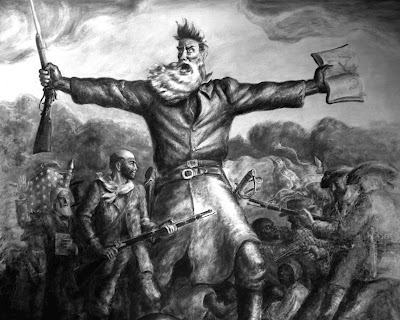 | Name: John Brown Tragic Prelude. Description: The Tragic Prelude. John Brown. Copy of mural by John Steuart Curry in the State Capitol in Topeka, KS, ca. 1937-42. (National Park Service) Exact Date Shot Unknown NARA FILE #: 079-CWC-3F-10 WAR & CONFLICT BOOK #: 115. Released to Public High Resolution Image |
Permission: This work is in the public domain in the United States because it is a work of the United States Federal Government under the terms of Title 17, Chapter 1, Section 105 of the US Code. See Copyright.
Note: This only applies to works of the Federal Government and not to the work of any individual U.S. state, territory, commonwealth, county, municipality, or any other subdivision.
other_versions: The Tragic Prelude. John Brown. Copy of mural by John Steuart Curry in the State Capitol in Topeka, Kansas, circa 1937-42., 1957 - 1965. ARC Identifier: 520060. Local Identifier: 79-CWC-3F(10). Access Restrictions: Unrestricted. Use Restrictions: Unrestricted.
Bleeding Kansas From Wikipedia, the free encyclopedia
Bleeding Kansas, sometimes referred to in history as Bloody Kansas or the Border War, was a sequence of violent events involving Free-Staters (anti-slavery) and pro-slavery "Border Ruffians" elements that took place in Kansas Territory and the western frontier towns of the U.S. state of Missouri between roughly 1854 and 1858 attempting to influence whether Kansas would enter the Union as a free or slave state. The term "Bleeding Kansas" was coined by Horace Greeley of the New York Tribune. The events in Bleeding Kansas directly presaged the American Civil War.
The Kansas-Nebraska Act of 1854 created the territory and provided the cause of the ensuing guerilla warfare. Enshrined in the Kansas–Nebraska Act, which nullified the Missouri Compromise, is the principle now known as "popular sovereignty", an idea heavily supported by U.S. Senator Stephen A. Douglas, chairman of the Senate Committee on Territories. Popular sovereignty was an attempt to offer concessions to the Southern states through making possible the expansion of slavery into both western and northern territories. Popular sovereignty, also known in Kansas Territory as squatter sovereignty, was first developed by U.S. Senator Lewis Cass.
The act established that the question of the expansion of slavery in the new states of Kansas and Nebraska would be decided by the inhabitants of the states. Initially, it was assumed that few slaveowners would attempt to settle in Kansas and make it a slave state, because it was thought to be too far north for profitable exploitation of slaves. However, the eastern portion of Kansas along the Missouri river was as suitable for slave-based agriculture as the nearby 'black belt' of Missouri in which most of Missouri's slaves were held.
The settlement and formation of the state government in Kansas became highly politicized beyond the borders of the territory. There were a number of reasons for this. Missouri, a slave state, was uniquely exposed to free states, with Illinois and Iowa bordering it on the east and north. Most parts of Missouri held very few slaves, and slaveowners were a very small proportion of the state's population. If Kansas entered the Union as a free state, Missouri would have free soil on three sides. Since manumission, abolition activity, and escape were all more common in the border south, the existence of nearby free soil was a threat to Missouri slaveowners.
Also, in the Senate, each state is apportioned two senate seats. A rough balance had existed between free and slave states, but each addition of a state threatened to tip the balance, disrupting the status quo.
This article is licensed under the GNU Free Documentation License. It uses material from the Wikipedia article, Bleeding Kansas














No comments:
Post a Comment